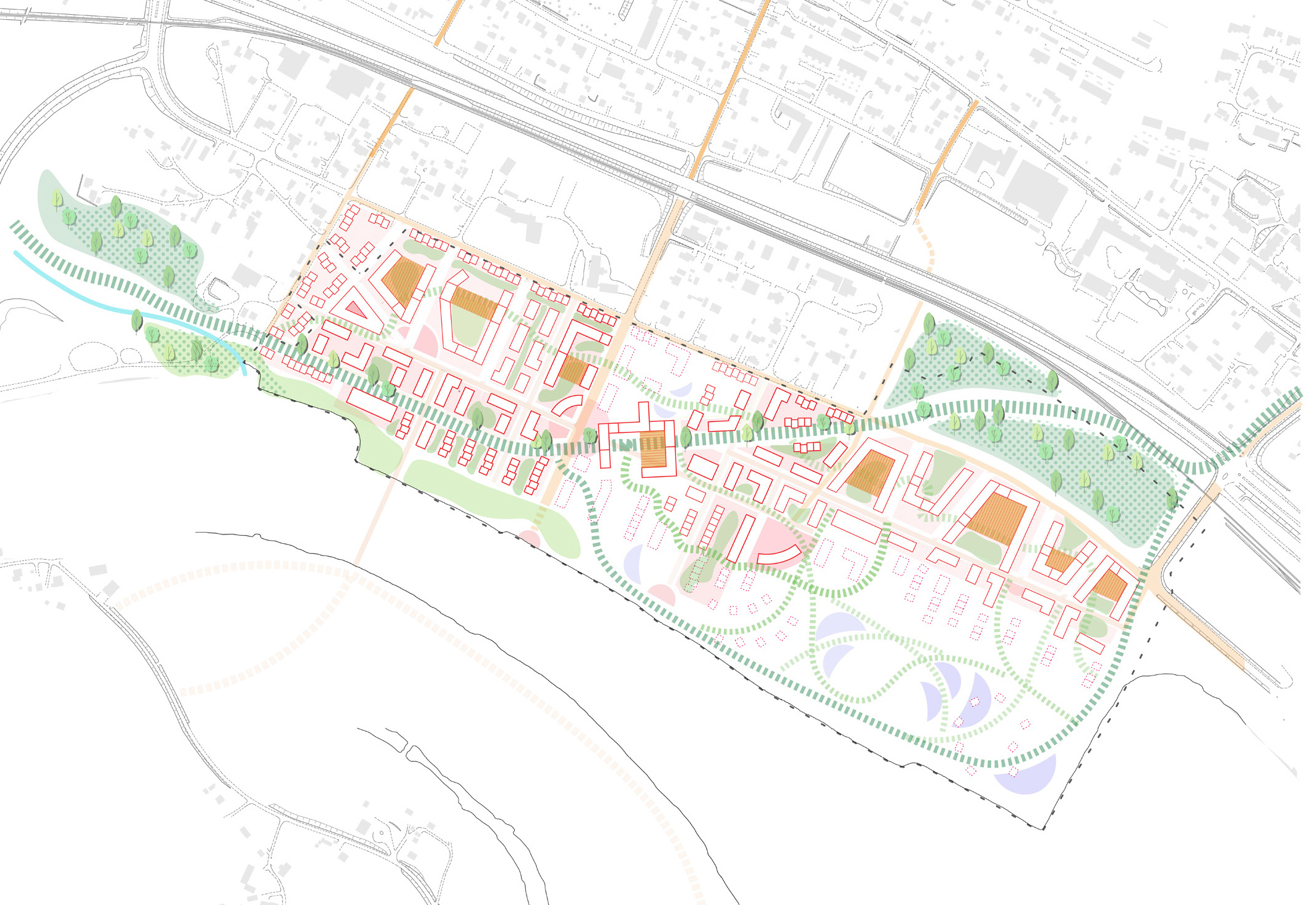Journeys of Care - Europan 17
Project “Journeys of Care. Towards the green transition of Skellefteå” in collaboration with Meike Wernecke, Ariadna Ferrer, Mariia Smoliakova and Valeriiaa Tatianina
May-July 2023
Project “Journeys of Care. Towards the green transition of Skellefteå” in collaboration with Meike Wernecke, Ariadna Ferrer, Mariia Smoliakova and Valeriiaa Tatianina
May-July 2023
Skellefteå is the departure point for the new green industries in the north of Sweden. The project takes on a journey to a site with an industrial history, through the process of ecological remediation and a new urban development. The urban journey accommodates different housing typologies with access to cultural activities. The natural journey formulates a green corridor that connects a stream with a dense birch area to create climate shelters and access to water. The regenerative journey allows exploration of the phytoremediation gardens with vegetation that will allow better soil conditions for future developments. By weaving together these journeys, the proposal contains three stages that adapt to previous experiences to host the diversity required to inhabit a post-industrial site.
“It's not about the destination, but the journey.”


The compass is a device which shows the directions of each journey (urban, natural, and regenerative). It presents where the journeys take place, at what time of the year and what activities are possible to perform, creating an intensity and concentration of them. Due to the industrial history of the site the key contaminants (dioxin, oil, heavy metals and arsenic) informed the species selection, where the vegetation (Salix, Alfalfa, Poplar, Flax, Atriplex, Lakritsrot) is introduced to grow and optimise the soil, creating a specific landscape and climate conditions which need to be taken into account when locating the activities into the site. The soil remediation consists of a combination of phyto-(plant), myco- (fungal) and bacterial remediation. The journeys navigate different kinds of places according to its accessibility (public (open,closed), semi public, semi private, private) to create diversification so inhabitants have the opportunity to participate in different types of activities all year around.

Analysis
connectivity
The project needs to consider the distances between the different scales of intervention from what one can access in 10, 15, 25 and 45 minutes from the site to the city center and other cities of the region (North Bothnia line). The rehabilitation of a mobility corridor from the battery factory in Hedensbyn will allow sustainable transportation to the port. By bridging towards Stackgrönnan, the camping and museum area can be accessed through the new development.
ecology
By taking care of the soil that is contaminated due to the traces of the wood pulp industry, the project has the opportunity to reclaim the area, to give spaces for new ecologies as a meeting place. The insertion of specific vegetation and bacteria will help in the remediation process of the soil, continuing the 10-years work of remediation by the municipality. Existing paths, water streams and the river need to be connected to allow the future inhabitants to access the natural spaces and waterfront and enjoy its ecosystem services. A cycling, walking and skiing corridor can connect the cultural area of Nordanå from the city center to the port at the borders of the river.
urbanity
The site offers space for new families, workers of the battery factory, students of the Campus Skellefteå and for those who left in and come back. It is primarily surrounded by residential areas which creates the potential for the addition of other uses and services as the support to the life of people with different backgrounds and make the area a place to stay.

Strategies

The regenerative journey
- Accessibility to the built surroundings (streets, schools and church, Ursviken area)
- Treatment of previous decontaminated soil areas with a selected vegetation strategy, called remediation gardens.
- Paths and contemplation areas to visualize and maintain the remediation. The area is an educational example of how certain plants are allowed to grow and how people learn to care in order to decontaminate the area overtime.
The natural journey
- The corridor connects the existing green and stream. It allows the insertion of high vegetation into the site, since the green corridor is located on the former train tracks which were used to run to the factory. This path is uncontaminated soil, consequently the planting of taller species with more roots is possible.
- Waterfront and open areas, programmed with summer and winter activities. For example, areas to pile up snow during winter, create artificial mounds for playing/ tobogganing.
The urban journey
- Urban cores such as the nurseries, research center, co-working and commercial areas (bus stops, sports)
- Adding different types of housing typologies allow different types of accommodation. (permanent and temporary homes) (1 courtyards, 2 active ground floors, 3 public buildings, 4 townhouses and 5 cabins in open areas).
Implementation over time



Stage 1
Activated cores around the green corridor
The proposal starts with preparation of the site and urbanization of the area around the corridor. The early introduction of planting associations for the remediation gardens will not only bring people together but also give an educational purpose to the area (though public buildings like the research center and the nurseries). Sowing seeds, testing, growing, monitoring, and maintaining the remediation gardens are key activities for the development of the site during the first stage.
Stage 2
Softening the borders towards the remediation gardens
The introduction of more density to the site will define the space as well as the addition of more housing typologies. The availability of different options for accommodation makes the area diverse (building apartments, cluster living, intergenerational housing, student and senior living, hotels, guest houses, vacation rentals, farm stay, camping sites). Key components of the area are meeting spaces, which will be climate smart in order to function throughout the whole year (greenhouses, courtyards, active ground floors) around as well as the relationship between locals and newcomers (renting a room of one's townhouse).
Stage 3
Expanding urban structure to the remediating areas
By learning from previous stages, the remediation gardens are ready to be urbanized with low density solutions according to the needs for housing. Most of them are located in a zone prone to the rising of sea level so the housing typologies have to adapt to these climate conditions. The remediation areas are consolidated with paths around them which function all year around.


The diary of the journey
The images allow to visualize the use of spaces in the site with different activities from the journeys.

check more projects:
